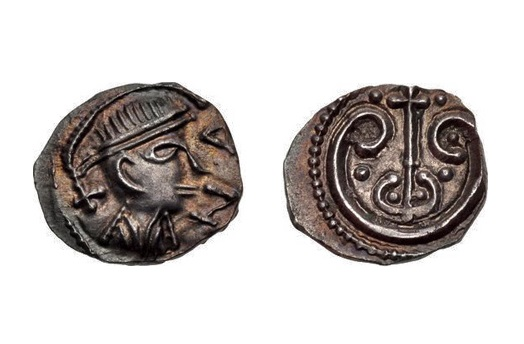
about ancient nomos
Ancient Nomos Art is a museum of galleries exhibiting ancient coins and ancient mint maps. The coin gallery displays the diverse art and history of hand-crafted ancient Greek, Roman, Byzantine, Persian and Medieval coinage. The ancient mints mapping gallery features Greek, Roman, Byzantine, Asia Minor and Medieval mint city regions and territories. Visitor's are welcome to explore, study and enjoy Ancient Nomos Art.

Medieval, France – 700 AD
Merovingian King
From Ancient Galleries

Obverse: Diademed bust of Merovingian King facing right; NA before, X cross behind.
Reverse: Cross ancrée in center, small pellets at all points; all within double volute circle.
LEGEND
Obv: Diademed bust of Frankish King facing right; NA before, X cross behind. Rev: Cross ancrée (with anchor) in center, eight pellets at all points; cross within an open circle terminated by two volutes; all within a beaded border.
The above early Middle Age coin is a superb example of the third and final mature phase of medieval Merovingian coinage. According to French tradition, the medieval Merovingian kingdom and subsequent dynasties descended from the Francia king Meroveus, the leader of the Salians. Meroveus had a son named Childeric I whose own grandson was the famed Clovis I, founder of the first Francia monarchy. After the death of Clovis I in 511 AD, the “unofficial” medieval Merovingian kingdom was subdivided into four distinct regions that included; Austrasia, Neustria, Burgundy and Aquitaine. By 630 AD, the subsequent Merovingian kings were able to unite the four regions into a single realm. Shortly after unification, the Merovingian’s began issuing the silver denier above. This silver coin represents one of the most significant transformations in the history of western coinage since the Roman Republican denarius. The new Merovingian denier marks the first systematic substitution of silver over the previous Byzantine Empire’s preferential use of gold. Within one century the silver denier would become the leading coinage in use throughout Europe and England. Some compare this historic transformation to the first Roman silver denarius issues after the 2nd Punic War, becoming the work horse of the Roman economy nine centuries earlier. The sudden substitution from gold to silver is thought to have been made for mainly economic reasons. However, unlike coinage controlled by government authority or by a state jurisdiction, Merovingian currency was largely dictated by a decentralized “open-market” of medieval monopolies controlled by a guild of individual Moneyors. It is believed that the shortage of gold enabled the medieval Moneyors, having exclusive minting authority, to abruptly change the early Middle Age economy to a silver based legal tender coinage. The exquisite specimen above features the Moneyors initials, NA, in the field to the right of the diademed bust of the reigning Frankish king facing to the right. The obverse symbol X, in the fields behind the king, represents the coins mark of value. The detailed reverse features a classic Middle Age Cross ancrée (with symbolic anchors) in the coins center. There are eight small pellets at each point of the cross in fields. The Christian cross is contained within an open circle terminated at its ends by two volute designs. Both the obverse and reverse images are engraved within a protective circular beaded border. Within a few short years, the new Merovingian silver denier, valued at approximately one-fortieth of the gold solidus, would quickly become a preferred medieval trade coinage, both within the Frankish kingdom itself and externally with its major German and English trading partners. As a result, the earlier Byzantium based gold solidus and gold triens became more and more obsolete, and the Merovingian silver denier of Francia strengthened, eventually evolving to become the most powerful coinage of medieval Europe.
DOCUMENTATION
Value: Denier. Metal: AR Silver. Weight: 1.13 grams. Mint: Quentovic, Neustria(?) Date: 700-725 AD.
Attribution: NM 9 (Indeterminees – croix ancrée); cf. Belfort 5727-30; Prou 2890-3; Morel-Fatio, Deniers Merovingiens de la Trouvaille de Cimiez, Pl. XI, 223. Medieval European Coinage 1. Photo Courtesy CNG.
Legend, Documentation and Attribution
